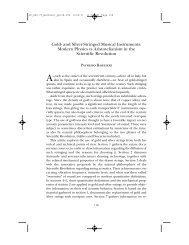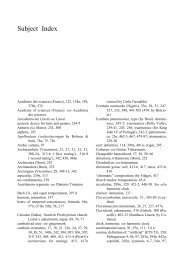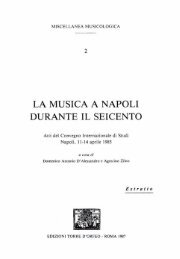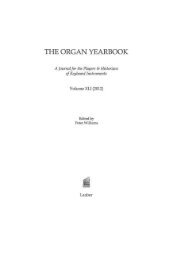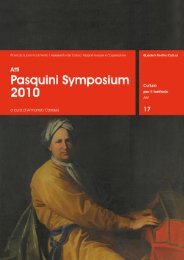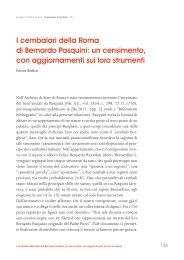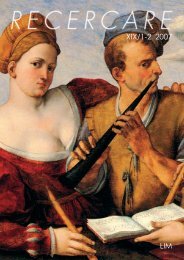Music-selling in seventeenth-century Rome: three ... - Patrizio Barbieri
Music-selling in seventeenth-century Rome: three ... - Patrizio Barbieri
Music-selling in seventeenth-century Rome: three ... - Patrizio Barbieri
You also want an ePaper? Increase the reach of your titles
YUMPU automatically turns print PDFs into web optimized ePapers that Google loves.
<strong>Music</strong>-<strong>sell<strong>in</strong>g</strong> <strong>in</strong> <strong>seventeenth</strong>-<strong>century</strong> <strong>Rome</strong> 143Table 4. Number of musical works published by Italian publishers (data from carter, “<strong>Music</strong>publish<strong>in</strong>g <strong>in</strong> Italy, c.1580-c.1625”, p. 21).year sacredno.secularno.<strong>in</strong>strumentalno.1585 29 66 41600 35 54 31620 62 30 52.3. The music: sacred vs secular. In Table 3 we see that <strong>in</strong> the 1586 <strong>in</strong>ventory secularmusic is more than double sacred music, and this ratio is still more favourable to thesecular sector with reference to the average of music published <strong>in</strong> Italy <strong>in</strong> those years(Table 4). This fact is also recorded <strong>in</strong> Florence for the same period. 44 In the 1621<strong>in</strong>ventory, on the other hand, the opposite is true and the ratio <strong>in</strong>verse, and here tooit is <strong>in</strong> harmony with the average given by Table 4: this imbalance however is alwayssuch as to attenuate the penalty suffered by secular music dur<strong>in</strong>g this period (<strong>in</strong> Table4 the sacred-secular ratio is slightly higher than 2, while <strong>in</strong> Table 3 it is slightly lower).This difference is decidedly attenuated <strong>in</strong> the 1633 <strong>in</strong>ventory. It thus appears that thebooksellers’ customers preferred secular music.The churches probably had other procurement channels, possibly through themaestri di cappella themselves. This is the case, for example, of Francesco Soriano,magister of the basilica of St. Peter’s: <strong>in</strong> a deed dated 1612, we learn that he had employedGiovanni Battista Robletti to pr<strong>in</strong>t for him “some of his musical works” andthat, <strong>in</strong> the same year, he collected from the said pr<strong>in</strong>ter 25 “volumes of masses”composed by him, at the price of two scudi each. 45 This bus<strong>in</strong>ess relationship musthave gone on for years, s<strong>in</strong>ce another deed dated 1628 tells us that Soriano had leftRobletti 20 scudi for the correction of some of his musical works. 46 Consequently,it is clear for this very reason that, strangely, a well-known composer like Soriano(1549–1621) does not appear <strong>in</strong> the <strong>in</strong>ventories of 1621 and 1633 (= 1625). The samecan be said – although to a lesser extent – of Palestr<strong>in</strong>a and Giovanni Luca Conforti,s<strong>in</strong>ce some of their works were pr<strong>in</strong>ted at their own expense. 47 To such a list wemay add the <strong>in</strong>strumental compositions by Girolamo Frescobaldi, by whom only as<strong>in</strong>gle work appears <strong>in</strong> the 1621 <strong>in</strong>ventory (the Toccate, pr<strong>in</strong>ted at his own expense <strong>in</strong>1615–16), while <strong>in</strong> the 1633 <strong>in</strong>ventory is totally absent. 48 The Franz<strong>in</strong>i-Carampelli do44. carter, “<strong>Music</strong>-<strong>sell<strong>in</strong>g</strong> <strong>in</strong> late sixteenth-<strong>century</strong> Florence”, p. 490.45. AS, 30 Not. Cap., uff. 9, vol. 94, f. 601, 5.12.1612.46. AS, 30 Not. Cap., uff. 13, vol. 244, f. 58, 6.7.1628.47. barbieri, “<strong>Music</strong> pr<strong>in</strong>ters”, p. 88. See also bernste<strong>in</strong>, “Publish or perish? Palestr<strong>in</strong>a and pr<strong>in</strong>tculture <strong>in</strong> 16th-<strong>century</strong> Italy”, p. 233.48. On the first volume of the Toccate, see arnaldo morelli, “Nuovi documenti frescobaldiani: icontratti per l’edizione del primo libro di Toccate”, Studi musicali, xvii, 1988, pp. 255–265. Also with regardto the second edition of the Recercari (Roma, B. Zannetti, 1618), <strong>in</strong> a private letter <strong>in</strong> that year, weread: “Io pensavo che se ne trovassi a’ librari, non c’è altri che lui [= Frescobaldi] che li venda comeopera sua”: gabriele giacomelli, “Fortuna dell’opera frescobaldiana <strong>in</strong> Toscana attraverso il carteggiodi Francesco Nigetti (1618–1657)”, L’organo, xxv-xxvi, 1987–88, pp. 97–112: 99 (on pp. 106–107 we learnthat as late as 1625 the situation was unchanged).



